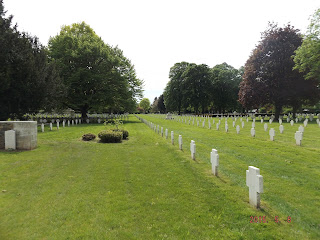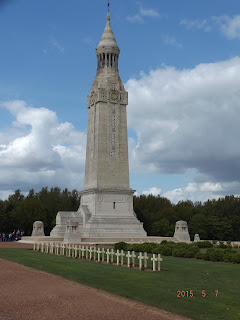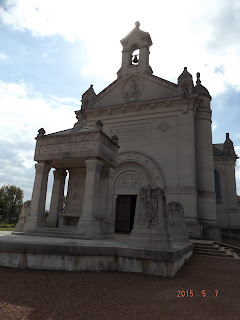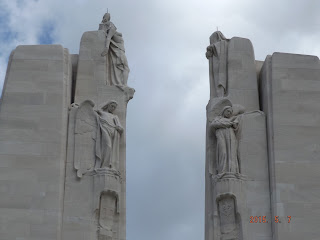A truly international affair - with French, German and commonwealth graves. A couple of notes ...
How far does 'remembrance' and memorial become divisive in themselves. In the week when the US has been discussing the place of the Confederate flag and whether it is or is not a reminder of slavery and race hate, the entrance to this cemetery talks of the gift of the French people to their allies of the land, but not to the Germans, whose graves are also there.
Also the memorial proclaiming how the sword divides but the cross unites, damaged by WW2 fire. How do we as churches reflect on the crosses of different nations filling a field. How can Christians around the world unite to prevent such tragedy. How can we act with Grace towards those who would strive with us for peace. To prevent further fields being filled with crosses, or stars, or crescents.
How very sad that German graves are shared by Jew and Christian, when within a few short years the Jew's family would be oppressed and murdered by the family of the Christian.
Friday, 26 June 2015
Thursday, 25 June 2015
Ring of remembrance
Just across the road from the Notre-Dame-de-Lorette is a new memorial, which reflects the new reality of a Europe where the former enemies are now allies. It was, for me, a truly inspiring place. It includes the names of all the dead on the Artois battlefields, with no ranks, or nationalities or religions mentioned. Just a catalogue of lives lost.
http://www.france24.com/en/20141110-hollande-opens-vast-new-memorial-wwi-dead
http://www.france24.com/en/20141110-hollande-opens-vast-new-memorial-wwi-dead
Notre-Dame-de-Lorette national necropolis
Unlike the Commonwealth plan to have lots of small cemeteries, the French collected their war dead into just a few huge areas. We visited Notre Dame de Lorette, on the next part of the battlefield to Vimy Ridge. Wiki page . The site was staffed by French veterans, who were wonderful, and spent a lot of time sharing with us in conversation. It was sad that they get so few non French visitors.
Wednesday, 24 June 2015
Vimy Ridge Canadian memorial.
In contrast to the manicured perfection of the British memorials, the Canadian's have left the signs of the conflict clear. We walked around the humps and bumps of overlapping shell holes, and through the sanitised concrete trenches. It added something to our understanding of the war.
The museum was interesting. We learned how the Canadians had won the war. They would have won it quicker without the British generals. It is notable that nearly every national memorial we visited gave a very particular view of the history of the western front. Perhaps the most rounded being those of Belgium and France - more of that later. It was sad thought to not read of the British soldiers whose graves were part of the same memorial as the Canadians.
The memorial itself was a great contrast to the solid blockiness of the Lutyen's commonwealth memorials. The Canadian memorial, I thought, pointed to a hopeful future born out of the mud and blood of the fighting. It reflects a nation that went to war on the coat-tails of the great imperial power of Britain, but emerged as a world respected power in its own right, with a place at the armistice negotiations. It is a wonderful piece of architectural sculpture. I wonder, though, if Canada as a nation truly mourns half dressed! If not, why is it idealised as doing so?
The museum was interesting. We learned how the Canadians had won the war. They would have won it quicker without the British generals. It is notable that nearly every national memorial we visited gave a very particular view of the history of the western front. Perhaps the most rounded being those of Belgium and France - more of that later. It was sad thought to not read of the British soldiers whose graves were part of the same memorial as the Canadians.
The memorial itself was a great contrast to the solid blockiness of the Lutyen's commonwealth memorials. The Canadian memorial, I thought, pointed to a hopeful future born out of the mud and blood of the fighting. It reflects a nation that went to war on the coat-tails of the great imperial power of Britain, but emerged as a world respected power in its own right, with a place at the armistice negotiations. It is a wonderful piece of architectural sculpture. I wonder, though, if Canada as a nation truly mourns half dressed! If not, why is it idealised as doing so?
Subscribe to:
Posts (Atom)








































































